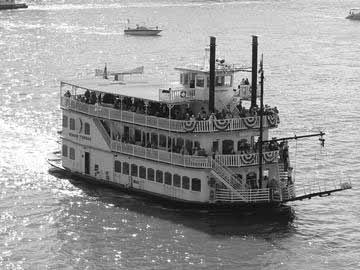PIRATE'S TREASURE HIDDEN IN CINCINNATI PARK
By Professor Thomas Henry Williamson, Historian
 Pirate's treasure is the stuff of a thousand adventure
stories, and finding it has made a few men throughout history very rich. One
cache of riches that no treasure hunter has yet found is that left behind by the
notorious pirate, Fat Nicholas of Hispaniola. My research has led me to the conclusion that
it
is hidden in the unlikeliest of places: Cincinnati Ohio.
Pirate's treasure is the stuff of a thousand adventure
stories, and finding it has made a few men throughout history very rich. One
cache of riches that no treasure hunter has yet found is that left behind by the
notorious pirate, Fat Nicholas of Hispaniola. My research has led me to the conclusion that
it
is hidden in the unlikeliest of places: Cincinnati Ohio.
"How can this be?" you ask. "A pirate would hide
his treasure some place he could sail,
or at least near the coast. That is no where near the coast!" With most
pirates, that statement would be true, but not so for Fat Nicholas of
Hispaniola. This infamous pirate was not only a traveler of the high seas, but
was originally from Mississippi, not Haiti or The Dominican Republic (the two
nations on the island of Hispaniola). He began his life of crime inland on fresh
waters robbing riverboats. In those days he was know as Nasty Nick of Natchez.
Until now, no one may have suspected that Fat Nicholas of Hispaniola and Nasty
Nick of Natchez were one in the same, but they most certainly were. I have
analyzed letters attributed to them. Handwriting analysis was no help, as the
pirate always dictated to a scribe with prettier handwriting than his own, and
the riverboat robber used his own hand, but the flowery poetic language and
clever use of double entendre are the same in both.
island of Hispaniola). He began his life of crime inland on fresh
waters robbing riverboats. In those days he was know as Nasty Nick of Natchez.
Until now, no one may have suspected that Fat Nicholas of Hispaniola and Nasty
Nick of Natchez were one in the same, but they most certainly were. I have
analyzed letters attributed to them. Handwriting analysis was no help, as the
pirate always dictated to a scribe with prettier handwriting than his own, and
the riverboat robber used his own hand, but the flowery poetic language and
clever use of double entendre are the same in both.
Nicholas D. LePetomaine, born sometime in the 1820s, was the illegitimate son of a Louisiana farmer's adventurous daughter, and a sailor she met in New Orleans. After he came along, his grandparents disowned his mother, and she left the farm forever to lead a life as a riverboat entertainer. She sang, danced, and became well know on the riverboat circuit. Young Nicholas was fascinated by tales of the father he never knew who had swept his mother off of her feet, and the high seas, which he would never give up. His favorite seafaring tales were those of pirates. Along the way, he met many people and learned many things. He became fluent in both French and Spanish. These would come in handy later in his life.
After several years of robbing riverboats, a bounty was placed the head of Nasty Nick so high that he knew he was not safe anywhere along the Mighty Mississip. The official story was that he simply disappeared, and may have been killed. My research suggests otherwise. He knew much about the seafaring life from trips to New Orleans and stories he had been told. Advertising for able-bodied men seeking adventure was a common way to recruit in port towns, both for legitimate merchant mariners and for pirates. Nicholas probably responded to such an ad, and left New Orleans bound for Port Au Prince or Santa Domingo.
He became a pirate. It wasn't long before he was the captain of his own ship, growing wealthy and very well fed. This led to the moniker, "Fat Nicholas." After swashbuckling through the Caribbean, Gulf of Mexico, and the Atlantic for decades, he decided to hide his stash, and he hid it so well that to this day its location is a secret. I am convinced that I know this secret. Nicholas wrote a poem about traveling to the garden of Eden and planting a precious seed. It describes sailing the Euphrates and the Hiddekel rivers. It also mentioned, seemingly in passing, a confluence of the Pison and the Gihon. If you are familiar with the Book of Genesis, you recognize these rivers. The poem also mentions a city on seven hills.
To those who did not make the connection, and do not realize that Fat Nicholas and Nasty Nick were the same person, the poem makes no sense. It reads as if he were using opium, or was otherwise intoxicated while writing it. To me, it makes perfect sense. Nicholas D. LePetomaine returned to the riverboats of his youth, and rode them to a hiding spot that no one would suspect. The Euphrates is a metaphor for the Mississippi. This seems plain. The Hiddekel represents the Ohio. His mention of the confluence of the Pison and Gihon makes this conclusion unavoidable, as the Ohio is formed by the confluence of the Allegheny and Monongahela rivers. This might lead one to conclude that the treasure is right at that point, in Pittsburgh Pennsylvania. This would be an error, because the city on seven hills can only be Cincinnati Ohio, and the precious seed he planted in the garden of Eden refers to Eden Park. His treasure is certainly buried there. No other location makes any sense based upon his writings. If uncovered, Fat Nicholas of Hispaniola's treasure would be worth tens of millions of dollars. Its value might even go over one hundred million.